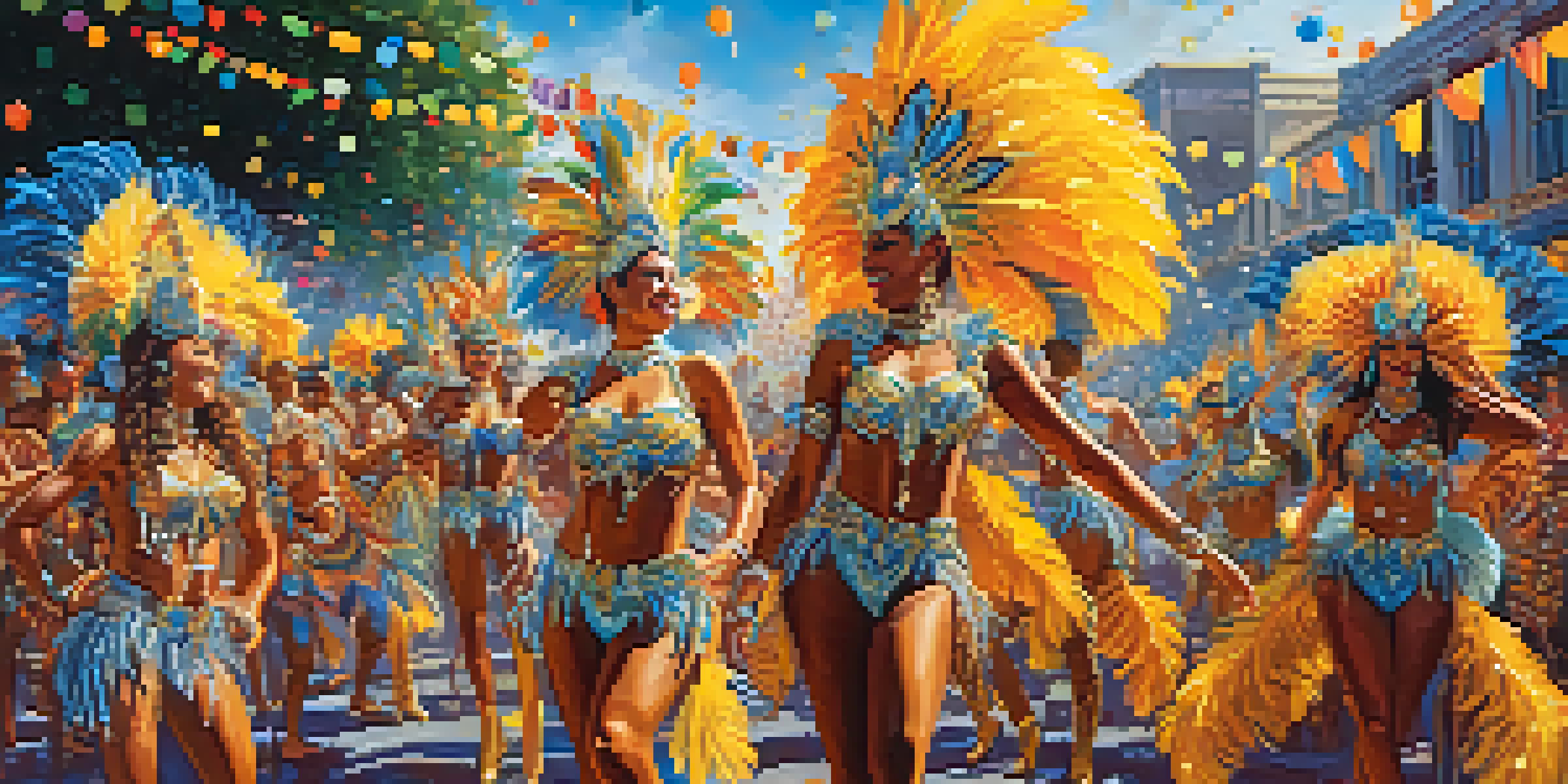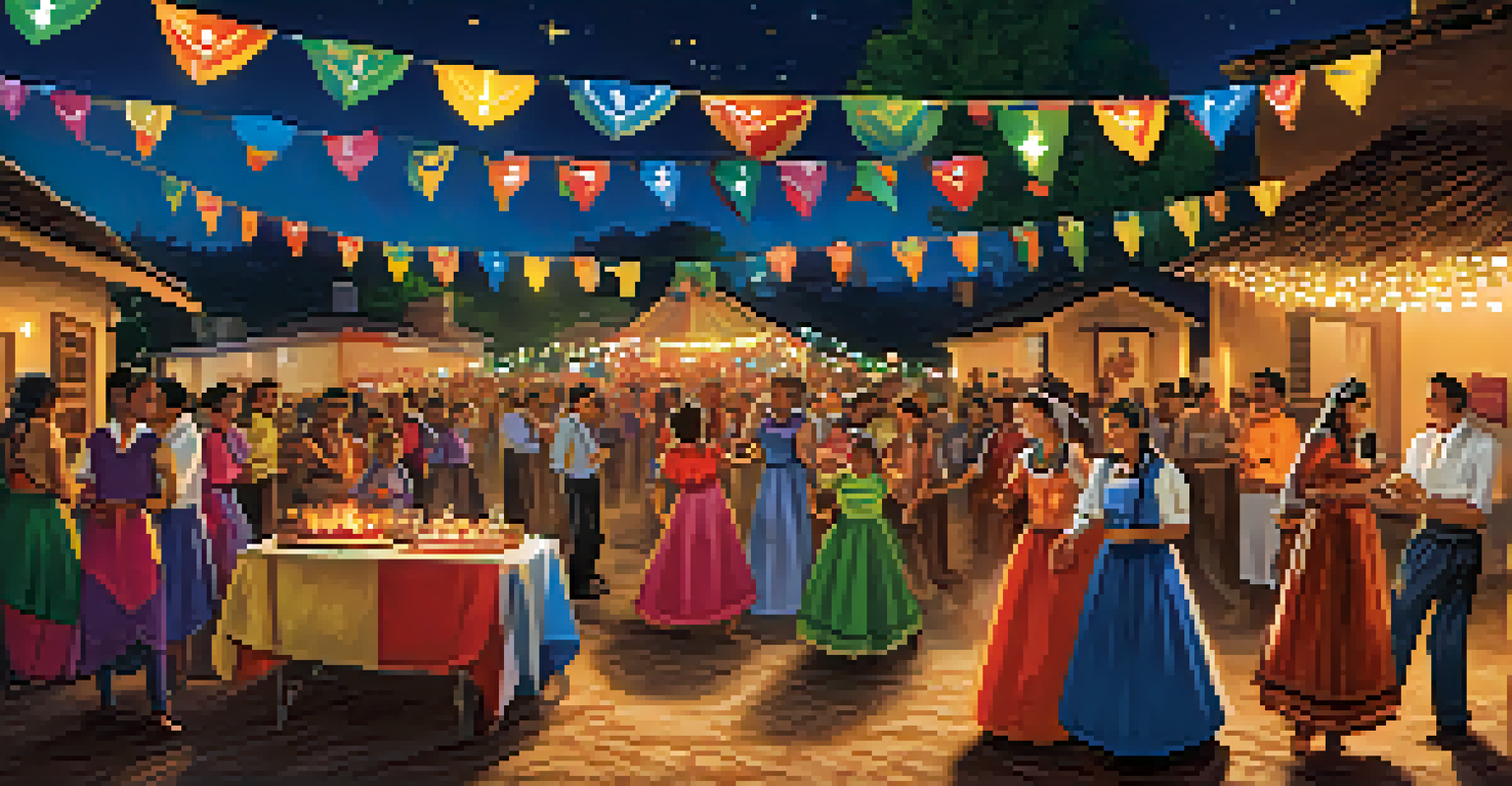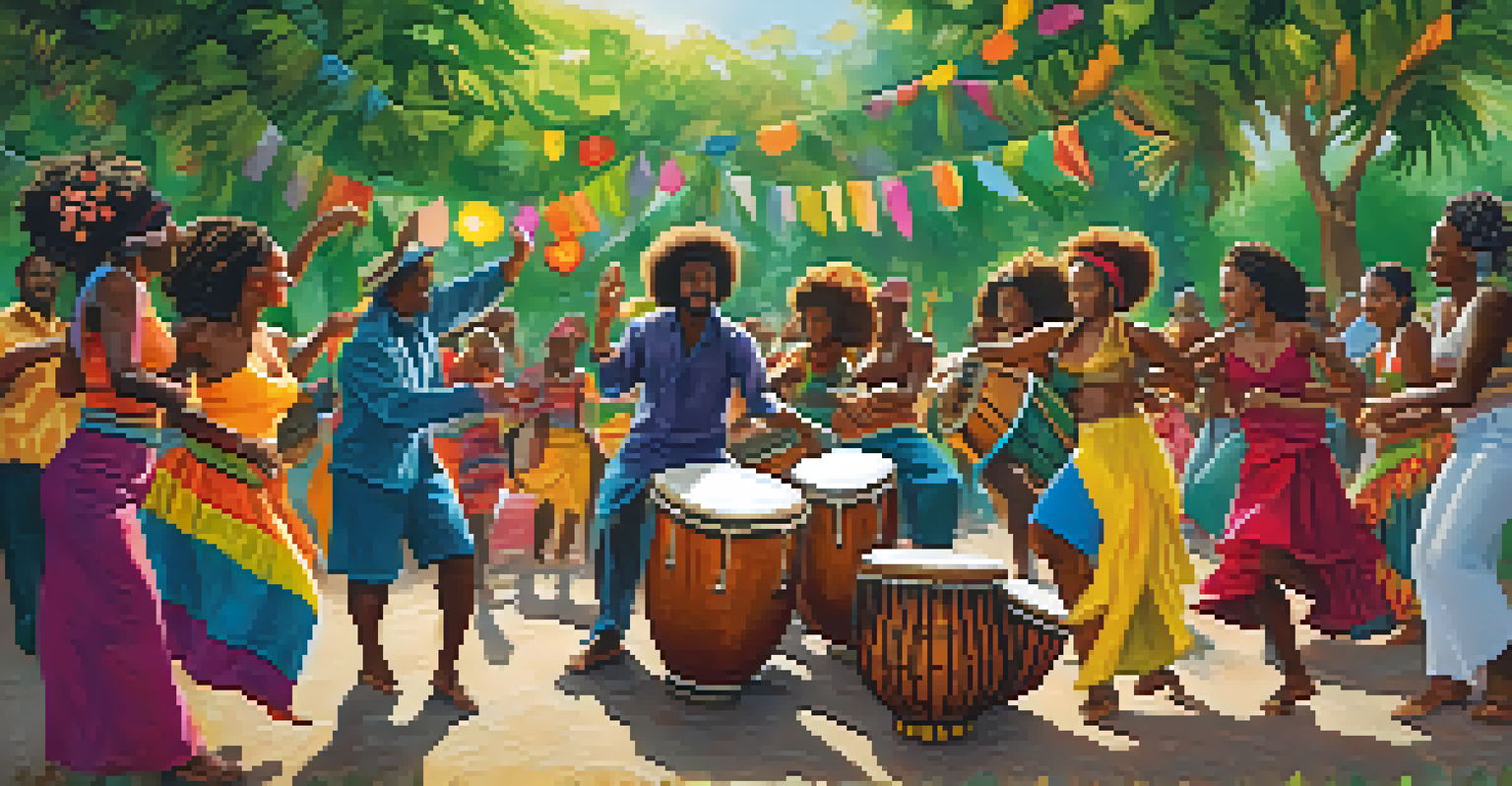The Role of Music and Dance in Brazilian Holiday Celebrations

The Heartbeat of Brazil: Music's Role in Celebrations
In Brazil, music is more than just entertainment; it's the soul of every celebration. From the vibrant rhythms of samba to the enchanting melodies of bossa nova, music sets the tone for joy and community. During holidays, these musical styles come alive, weaving through the air and inviting everyone to participate in the festivities.
Music can change the world because it can change people.
For example, during Carnival, the streets pulse with samba beats, prompting spontaneous dance-offs and parades that can last for days. This connection between music and celebration fosters a sense of unity, allowing people from all walks of life to come together. It's a beautiful reminder of how music can elevate our spirits and connect us to one another.
Moreover, music serves as a cultural bridge, showcasing Brazil's rich diversity. Each region has its own musical traditions that reflect its history and heritage, making holidays a colorful tapestry of sounds. This melting pot of influences is what makes Brazilian holidays unforgettable.
Dance: The Expression of Brazilian Culture
Dance is another fundamental aspect of Brazilian holiday celebrations, embodying the rhythm and energy of the nation. Whether it’s the graceful movements of capoeira or the lively steps of forró, dance provides a physical expression of joy and community connection. During holidays, you’ll often find people dancing in the streets, turning every corner into a spontaneous party.

Take the popular Festa Junina, for instance, where traditional dances like quadrilha bring friends and families together. Dressed in colorful outfits, participants form circles and perform intricate steps, creating a visual spectacle that captivates onlookers. It's not just about the dance itself; it’s a celebration of culture, tradition, and togetherness.
Music Unites Brazil in Celebration
In Brazil, music acts as the heartbeat of celebrations, fostering joy and community through vibrant rhythms and diverse cultural expressions.
Furthermore, dance serves as a storytelling medium, conveying narratives passed down through generations. Each movement and rhythm carries the weight of history, allowing people to celebrate their identity while honoring their ancestors. This intertwining of dance and storytelling enriches the holiday experience, making it deeply meaningful.
Carnival: A Festival of Music and Dance
Carnival is arguably the most famous celebration in Brazil, and it exemplifies the powerful role of music and dance in holiday festivities. Held before Lent, this festival transforms cities into vibrant showcases of color, sound, and movement. Samba schools prepare all year for this moment, perfecting their music and choreography to compete in grand parades.
Dance is the hidden language of the soul.
During Carnival, the streets become alive with the sounds of drums and trumpets, while dancers clad in dazzling costumes perform intricate routines. This energetic atmosphere draws locals and tourists alike, creating a sense of camaraderie among participants. People of all ages join in, dancing and celebrating together, showcasing the festival's inclusive spirit.
The impact of Carnival goes beyond just entertainment; it’s a reflection of Brazil's cultural identity. The fusion of various musical styles and dance forms creates a rich experience that honors the country's diverse heritage. This celebration allows people to express their creativity and passion, making it a pivotal moment in Brazil’s holiday calendar.
Festa Junina: Celebrating Tradition with Dance and Music
Festa Junina offers a different yet equally vibrant celebration of Brazilian culture, typically held in June. This festival honors rural traditions, featuring folk music and traditional dances that bring communities together. The lively atmosphere is filled with the sounds of accordion and traditional songs, inviting everyone to join in the fun.
At the heart of Festa Junina are the quadrilha dances, where couples perform choreographed steps in colorful outfits. This dance is reminiscent of square dancing and provides a sense of nostalgia for many Brazilians. The festival creates a joyful environment where families gather to celebrate their heritage through music, dance, and delicious traditional foods.
Dance as Cultural Expression
Dance embodies the energy of Brazilian culture, serving as a physical manifestation of joy and storytelling during holiday festivities.
Not only does Festa Junina preserve cultural traditions, but it also fosters community spirit. Neighborhoods come alive with decorations, bonfires, and music, encouraging participation from everyone. This showcases how music and dance play a crucial role in maintaining cultural ties and celebrating shared identities.
The Influence of Afro-Brazilian Music on Celebrations
Afro-Brazilian music significantly influences Brazil's holiday celebrations, infusing them with rich rhythms and cultural narratives. Genres like samba, axé, and maracatu have roots in African musical traditions, and they bring a unique flavor to festivals. This connection highlights the important role of African heritage in shaping Brazil's cultural landscape.
During celebrations, you can often hear the powerful beats of drums that are central to Afro-Brazilian music, inviting people to dance and celebrate together. This rhythmic foundation creates an exhilarating atmosphere, encouraging spontaneous dancing and communal joy. It’s a beautiful example of how music can transcend boundaries and unite people in celebration.
Additionally, the storytelling aspect of Afro-Brazilian music adds depth to holiday celebrations. Lyrics often reflect historical struggles, community pride, and resilience, reminding participants of their roots. This cultural richness enhances the experience, making each celebration a powerful reminder of collective identity and shared history.
Modern Influences: Blending Tradition with Contemporary Styles
As Brazil evolves, so does its music and dance, with modern influences blending seamlessly with traditional styles. Genres like funk carioca and electronic samba have emerged, attracting younger generations and creating new forms of expression. This fusion showcases the dynamic nature of Brazilian culture and its ability to adapt while preserving its essence.
During holiday celebrations, you might witness a mix of traditional dances alongside contemporary styles, creating an exciting atmosphere. This blending of old and new invites diverse audiences to participate, ensuring that the cultural heritage remains vibrant and relevant. It’s a testament to how music and dance continue to evolve while honoring their roots.
Modern Influences Revitalize Traditions
Contemporary music and dance styles blend with traditional forms, ensuring that Brazil's rich cultural heritage remains vibrant and relevant.
Moreover, these modern influences open up opportunities for collaboration and innovation. Artists experiment with sounds and movements, leading to unique performances that reflect the current zeitgeist. This not only keeps the holiday celebrations fresh and engaging but also encourages creative expression across generations.
The Power of Music and Dance in Building Community
Ultimately, the role of music and dance in Brazilian holiday celebrations goes beyond entertainment; it fosters community and connection. These elements create a shared language that transcends cultural and social barriers, bringing people together in joyous celebration. Whether it’s a local festival or a national event, the spirit of togetherness is palpable.
When people dance together, they forge bonds that often last a lifetime. The shared experience of music and movement cultivates a sense of belonging and identity, allowing individuals to feel part of something greater. This communal aspect is especially important in holiday celebrations, where the focus is on unity and joy.

Additionally, music and dance serve as a means of cultural preservation. They allow communities to pass down traditions and stories from one generation to the next, ensuring that their heritage remains alive. In this way, every celebration becomes an opportunity to connect, reflect, and honor the past while looking toward the future.